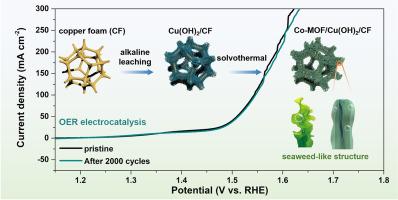海藻状 Co-MOF/Cu(OH)2/CF 复合材料作为氧进化反应的高级前催化剂
IF 8.1
2区 工程技术
Q1 CHEMISTRY, PHYSICAL
引用次数: 0
摘要
由于金属有机框架(MOFs)缺乏暴露的活性位点、电子电导率低、结构稳定性差,直接将其用作氧进化反应(OER)的电催化剂或预催化剂面临着巨大挑战。本文提出了一种新颖的碱性浸出-溶热策略,在泡沫铜(CF)上合成海藻状 Co-MOF/Cu(OH)2,并将其用作氧进化反应的自支撑前催化剂。电化学活化后,Co-MOF/Cu(OH)2/CF 在 50 mA cm-2 的条件下只需要 279 mV 的过电位,并可稳定运行 72 小时,活性衰减几乎可以忽略不计。高活性和稳定性主要得益于其独特的结构排列,其中 Cu(OH)2 纳米针是生长和稳定 Co-MOF 的牢固基底。二维 Co-MOFs 具有纳米厚度和高可触及表面,可暴露出足够的金属配位位点,为重构和电催化做好了准备。此外,CF 框架有助于维持自支撑结构,并在 OER 过程中充当集流器,提高电荷/电子转移效率。本文章由计算机程序翻译,如有差异,请以英文原文为准。

Seaweed-like Co-MOF/Cu(OH)2/CF composite as an advanced pre-catalyst for oxygen evolution reaction
Directly applying metal-organic frameworks (MOFs) as electrocatalysts or pre-catalysts for the oxygen evolution reaction (OER) faces significant challenges, due to the lack of exposed active sites, low electronic conductivity, and poor structure stability. Herein, a novel alkaline leaching-solvothermal strategy is proposed to synthesize seaweed-like Co-MOF/Cu(OH)2 on copper foam (CF), which is applied as self-supporting pre-catalyst for OER. After electrochemical activation, Co-MOF/Cu(OH)2/CF only requires an overpotential of 279 mV at 50 mA cm−2 and operates steadily for 72 h with negligible activity deterioration. The high activity and stability mainly benefit from the unique structural arrangement, in which Cu(OH)2 nanoneedles serve as firm substrates to grow and stabilize Co-MOFs. The two-dimensional Co-MOFs with nanometer thickness and high accessible surfaces could expose sufficient metal coordination sites, which are ready for reconstruction and electrocatalysis. Additionally, CF framework helps to maintain the self-supporting structure and acts as current collector to enhance the charge/electron transfer efficiency during OER.
求助全文
通过发布文献求助,成功后即可免费获取论文全文。
去求助
来源期刊

International Journal of Hydrogen Energy
工程技术-环境科学
CiteScore
13.50
自引率
25.00%
发文量
3502
审稿时长
60 days
期刊介绍:
The objective of the International Journal of Hydrogen Energy is to facilitate the exchange of new ideas, technological advancements, and research findings in the field of Hydrogen Energy among scientists and engineers worldwide. This journal showcases original research, both analytical and experimental, covering various aspects of Hydrogen Energy. These include production, storage, transmission, utilization, enabling technologies, environmental impact, economic considerations, and global perspectives on hydrogen and its carriers such as NH3, CH4, alcohols, etc.
The utilization aspect encompasses various methods such as thermochemical (combustion), photochemical, electrochemical (fuel cells), and nuclear conversion of hydrogen, hydrogen isotopes, and hydrogen carriers into thermal, mechanical, and electrical energies. The applications of these energies can be found in transportation (including aerospace), industrial, commercial, and residential sectors.
 求助内容:
求助内容: 应助结果提醒方式:
应助结果提醒方式:


